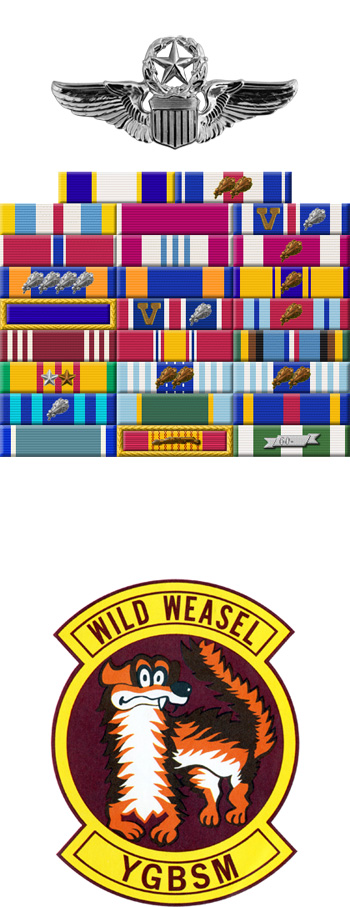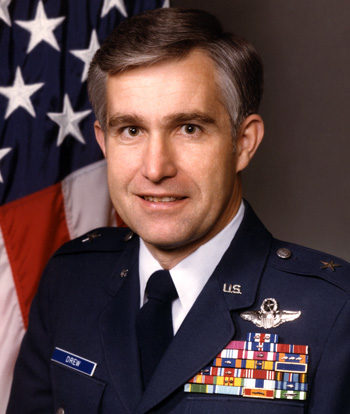
|
Philip M. Drew |
 |
|||
| Rank, Service | ||||
Brigadier General O-7, U.S. Air Force |
||||
| Veteran of: | ||||
|
||||
| Tribute: | ||||
Philip Drew was born on December 11, 1939, in Ashland, Kentucky. He enlisted in the Aviation Cadet Program of the U.S. Air Force on March 2, 1959, and was commissioned a 2d Lt and awarded his pilot wings at Greenville AFB, Mississippi, on June 14, 1960. After completing F-100 Super Sabre Combat Crew Training, Lt Drew was assigned to the 531st Tactical Fighter Squadron, first at Misawa AB, Japan, from June 1961 to June 1964, then at England AFB, Louisiana, from June 1964 to December 1965, and finally deployed to Bien Hoa AB, South Vietnam, from December 1965 to February 1966. Capt Drew next served as Aide-de-Camp to the deputy commander of 7th Air Force and 13th Air Force at Udorn Royal Thai AFB, Thailand, from February to September 1966, followed by F-105 Thunderchief Combat Crew Training and Wild Weasel training from October 1966 to June 1967. He then served as an F-105F Wild Weasel pilot with the 357th Tactical Fighter Squadron at Takhli Royal Thai AFB, Thailand, from June 1967 to March 1968, and then transitioned into the F-111 Aardvark, serving as a flight instructor with the 4527th Combat Crew Training Squadron and the 474th Tactical Fighter Wing at Nellis AFB, Nevada, from March 1968 to April 1969. During this time, Maj Drew completed his bachelor's degree in business administration at the University of Nebraska. His next assignment was as a test project officer with the 4537th Fighter Weapons Squadron at Nellis AFB from April to August 1969, followed by Air Command and Staff College at Maxwell AFB, Alabama, from August 1969 to June 1970. He then served as a liaison officer with the U.S. House of Representatives from July 1970 to February 1973, followed by F-4 Phantom II upgrade training from February to May 1973. Col Drew served with the 13th Tactical Fighter Squadron at Udorn Royal Thai AFB, Thailand, from May to December 1973, and then served with the 432nd Tactical Reconnaissance Wing at Udorn from December 1973 to May 1974. During his multiple tours in Southeast Asia, he flew over 350 combat missions and was credited with the destruction of 1 enemy aircraft in aerial combat. His next assignment was at Clark AB in the Philippines from June 1974 to May 1976, where he served as operations officer for the 90th Tactical Fighter Squadron, chief of the Aircrew Evaluation Division for the 3rd Tactical Fighter Wing, and then commander of the 3rd Organizational Maintenance Squadron. He next served on the staff of Headquarters Tactical Air Command at Langley AFB, Virginia, from May 1976 to June 1978, and he then completed National War College in July 1979. Col Drew served as chief of the NATO Organization Policy Branch with the Joint Chiefs of Staff in the Pentagon from July 1979 to January 1981, followed by service as vice commander of the 313th Air Division at Kadena AB, Okinawa, from March 1981 to August 1982. He was commander of the 18th Tactical Fighter Wing at Kadena from August 1982 to April 1984, and then served another tour with the Joint Chiefs of Staff from July 1984 to August 1986. Gen Drew's final assignment was as commander of the 65th Air Division at Sembach AB, West Germany, from August 1986 until his retirement from the Air Force on January 1, 1988. |
||||
|
||||

